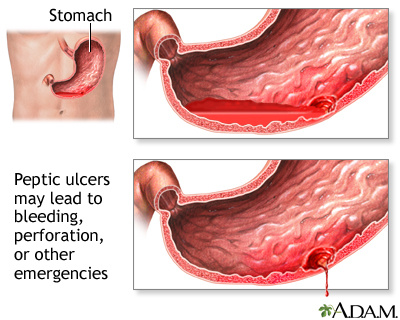Pregnancy SmartSiteTM
Stools - bloody; Melena; Stools - black or tarry; Upper gastrointestinal bleeding; Melenic stools DefinitionBlack or tarry stools with a foul smell are a sign of a problem in the upper digestive tract. It most often indicates that there is bleeding in the stomach, small intestine, or right side of the colon. The term melena is used to describe this finding. ConsiderationsEating black licorice, blueberries, blood sausage or taking iron pills, activated charcoal, or medicines that contain bismuth (such as Pepto-Bismol), can also cause black stools. Beets and foods with red coloring can sometimes make stools appear reddish. In all these cases, your doctor can test the stool with a chemical to rule out the presence of blood. Bleeding in the esophagus or stomach (such as with peptic ulcer disease) can also cause you to vomit blood. CausesThe color of the blood in the stools can indicate the source of bleeding.
 Peptic ulcers are the most common cause of acute upper GI bleeding. Black and tarry stools may also occur due to:
 When to Contact a Medical ProfessionalContact your health care provider right away if:
In children, a small amount of blood in the stool is most often not serious. The most common cause is constipation. You should still tell your child's provider if you notice this problem. What to Expect at Your Office VisitYour provider will take a medical history and perform a physical exam. The exam will focus on your abdomen. You may be asked the following questions:
You may need to have one or more tests to look for the cause:
Severe cases of bleeding that cause excessive blood loss and a drop in blood pressure may require surgery or hospitalization. ReferencesChaptini L, Peikin S. Gastrointestinal bleeding. In: Parrillo JE, Dellinger RP, eds. Critical Care Medicine: Principles of Diagnosis and Management in the Adult. 5th ed. Philadelphia, PA: Elsevier; 2019:chap 72. DeGeorge LM, Nable JV. Gastrointestinal bleeding. In: Walls RM, ed. Rosen's Emergency Medicine: Concepts and Clinical Practice. 10th ed. Philadelphia, PA: Elsevier; 2023:chap 26. Kovacs TO, Jensen DM. Gastrointestinal hemorrhage. In: Goldman L, Schafer AI, eds. Goldman-Cecil Medicine. 26th ed. Philadelphia, PA: Elsevier; 2020:chap 126. Savides TJ, Jensen DM. Gastrointestinal bleeding. In: Feldman M, Friedman LS, Brandt LJ, eds. Sleisenger and Fordtran's Gastrointestinal and Liver Disease. 11th ed. Philadelphia, PA: Elsevier; 2021:chap 20. | |
| |
Review Date: 5/4/2022 Reviewed By: Michael M. Phillips, MD, Emeritus Professor of Medicine, The George Washington University School of Medicine, Washington, DC. Also reviewed by David C. Dugdale, MD, Medical Director, Brenda Conaway, Editorial Director, and the A.D.A.M. Editorial team. The information provided herein should not be used during any medical emergency or for the diagnosis or treatment of any medical condition. A licensed medical professional should be consulted for diagnosis and treatment of any and all medical conditions. Links to other sites are provided for information only -- they do not constitute endorsements of those other sites. No warranty of any kind, either expressed or implied, is made as to the accuracy, reliability, timeliness, or correctness of any translations made by a third-party service of the information provided herein into any other language. © 1997- A.D.A.M., a business unit of Ebix, Inc. Any duplication or distribution of the information contained herein is strictly prohibited. | |

 Abdominal organs
Abdominal organs Ulcer emergencies
Ulcer emergencies Mallory-Weiss tear
Mallory-Weiss tear Capsule endoscopy
Capsule endoscopy
